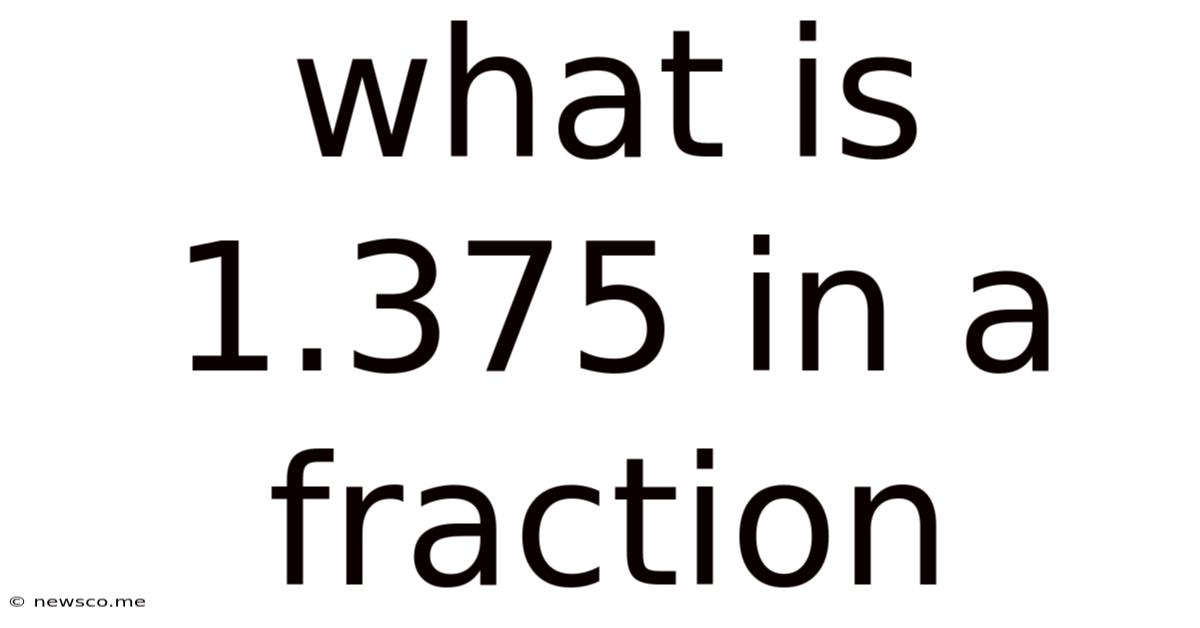What Is 1.375 In A Fraction
News Co
Apr 13, 2025 · 5 min read

Table of Contents
What is 1.375 as a Fraction? A Comprehensive Guide
Understanding decimal-to-fraction conversions is a fundamental skill in mathematics, crucial for various applications from basic arithmetic to advanced calculus. This comprehensive guide will explore how to convert the decimal 1.375 into its fractional equivalent, providing a detailed explanation and exploring related concepts. We'll not only show you how to do it but also why the process works, ensuring a thorough understanding.
Understanding Decimals and Fractions
Before diving into the conversion, let's refresh our understanding of decimals and fractions.
Decimals: Decimals represent numbers that are not whole numbers. They are based on the powers of 10, with each digit to the right of the decimal point representing a decreasing power of 10 (tenths, hundredths, thousandths, and so on). For instance, 1.375 can be broken down as:
- 1: Represents one whole unit.
- .3: Represents three-tenths (3/10).
- .07: Represents seven-hundredths (7/100).
- .005: Represents five-thousandths (5/1000).
Fractions: Fractions represent parts of a whole. They consist of a numerator (the top number) and a denominator (the bottom number). The numerator indicates how many parts you have, and the denominator indicates how many parts make up the whole. For example, 1/2 means one out of two equal parts.
Converting 1.375 to a Fraction: Step-by-Step Guide
Converting 1.375 to a fraction involves several steps:
Step 1: Identify the Place Value of the Last Digit
The last digit in 1.375 is 5, which is in the thousandths place. This means our denominator will be 1000.
Step 2: Write the Decimal Part as a Fraction
Remove the whole number (1) for now and focus solely on the decimal part, 0.375. We can write this as a fraction with 1000 as the denominator:
375/1000
Step 3: Simplify the Fraction
This fraction can be simplified by finding the greatest common divisor (GCD) of the numerator (375) and the denominator (1000). The GCD is the largest number that divides both 375 and 1000 without leaving a remainder. In this case, the GCD is 125.
Divide both the numerator and the denominator by 125:
375 ÷ 125 = 3 1000 ÷ 125 = 8
This simplifies our fraction to 3/8.
Step 4: Add the Whole Number Back
Remember the whole number 1 we initially set aside? Now, we add it back to our simplified fraction:
1 + 3/8 = 1 3/8
Therefore, 1.375 as a fraction is 1 3/8.
Alternative Method: Using Powers of Two
Another approach involves recognizing that 1.375 can be expressed as a sum of fractions with denominators that are powers of 2:
1.375 = 1 + 0.25 + 0.125
We can express each decimal part as a fraction:
- 0.25 = 1/4
- 0.125 = 1/8
Therefore:
1.375 = 1 + 1/4 + 1/8
To add these fractions, find a common denominator (8):
1.375 = 1 + 2/8 + 1/8 = 1 + 3/8 = 1 3/8
Converting Improper Fractions to Mixed Numbers
The result 1 3/8 is a mixed number, containing both a whole number and a fraction. Sometimes, the conversion might result in an improper fraction (where the numerator is larger than the denominator). Let's look at an example:
If we had a decimal like 2.75, following the steps above would lead to:
- Decimal part: 0.75
- Fraction: 75/100
- Simplified fraction: 3/4
- With whole number: 2 3/4
Practical Applications of Decimal-to-Fraction Conversion
Understanding how to convert decimals to fractions is incredibly useful in many contexts:
-
Cooking and Baking: Recipes often use fractions for precise measurements. Converting decimal measurements from a digital scale to fractional equivalents ensures accuracy.
-
Construction and Engineering: Precise measurements are vital in these fields. Converting decimals to fractions allows for greater accuracy and compatibility with traditional measurement systems.
-
Finance and Accounting: Calculations involving percentages often require converting decimals to fractions for simplification and accurate calculations.
-
Software Development: Some programming languages require fractional representations for certain data types.
-
Mathematics and Science: Decimal-to-fraction conversion is frequently necessary for various mathematical and scientific calculations and equation solving.
Beyond the Basics: Advanced Decimal-to-Fraction Conversions
While 1.375 is a relatively straightforward conversion, some decimals may result in fractions that are more challenging to simplify. For example, recurring decimals (like 0.333...) require a different approach that involves algebraic manipulation. However, the fundamental principles remain the same: identifying the place value, expressing the decimal as a fraction, and simplifying the fraction to its lowest terms.
Troubleshooting Common Mistakes
-
Incorrect Place Value: Ensure you correctly identify the place value of the last digit to determine the denominator.
-
Incorrect Simplification: Always simplify the fraction to its lowest terms by finding the greatest common divisor (GCD) of the numerator and denominator.
-
Forgetting the Whole Number: Remember to include the whole number part of the original decimal in your final answer.
Conclusion: Mastering Decimal-to-Fraction Conversions
Mastering the conversion of decimals to fractions is a valuable skill that improves mathematical fluency and problem-solving abilities. This guide has provided a comprehensive approach to converting 1.375 to its fractional equivalent (1 3/8) and explored related concepts. Remember the steps: identify the place value, express as a fraction, simplify, and add the whole number. With practice, you'll become proficient in this essential mathematical skill, enhancing your ability to work confidently with both decimal and fractional representations of numbers. By understanding the underlying principles, you'll be well-equipped to tackle more complex decimal-to-fraction conversions in various academic and professional contexts.
Latest Posts
Related Post
Thank you for visiting our website which covers about What Is 1.375 In A Fraction . We hope the information provided has been useful to you. Feel free to contact us if you have any questions or need further assistance. See you next time and don't miss to bookmark.